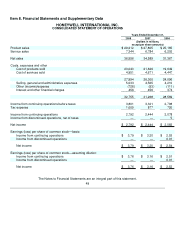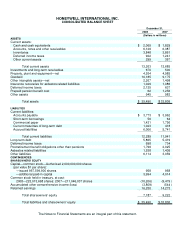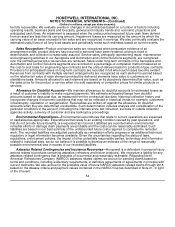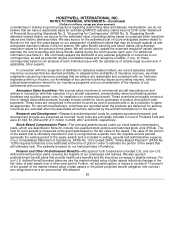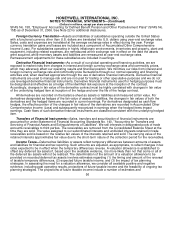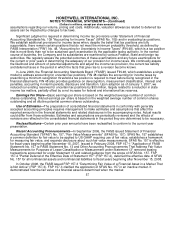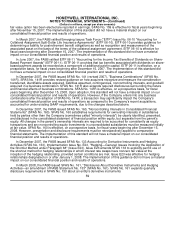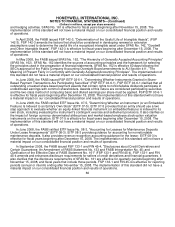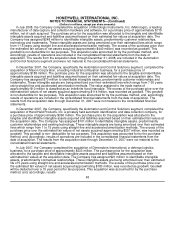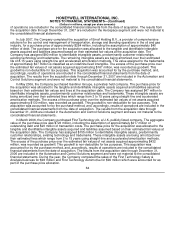Honeywell 2008 Annual Report Download - page 78
Download and view the complete annual report
Please find page 78 of the 2008 Honeywell annual report below. You can navigate through the pages in the report by either clicking on the pages listed below, or by using the keyword search tool below to find specific information within the annual report.
HONEYWELL INTERNATIONAL INC.
NOTES TO FINANCIAL STATEMENTS—(Continued)
(Dollars in millions, except per share amounts)
SFAS No. 158, "Employers' Accounting for Defined Benefit Pension and Other Postretirement Plans" (SFAS No.
158) as of December 31, 2006. See Note 22 for additional disclosures.
Foreign Currency Translation—Assets and liabilities of subsidiaries operating outside the United States
with a functional currency other than U.S. dollars are translated into U.S. dollars using year-end exchange rates.
Sales, costs and expenses are translated at the average exchange rates in effect during the year. Foreign
currency translation gains and losses are included as a component of Accumulated Other Comprehensive
Income (Loss). For subsidiaries operating in highly inflationary environments, inventories and property, plant and
equipment, including related expenses, are remeasured at the exchange rate in effect on the date the assets
were acquired, while monetary assets and liabilities are remeasured at year-end exchange rates.
Remeasurement adjustments for these subsidiaries are included in earnings.
Derivative Financial Instruments—As a result of our global operating and financing activities, we are
exposed to market risks from changes in interest and foreign currency exchange rates and commodity prices,
which may adversely affect our operating results and financial position. We minimize our risks from interest and
foreign currency exchange rate and commodity price fluctuations through our normal operating and financing
activities and, when deemed appropriate through the use of derivative financial instruments. Derivative financial
instruments are used to manage risk and are not used for trading or other speculative purposes and we do not
use leveraged derivative financial instruments. Derivative financial instruments used for hedging purposes must
be designated and effective as a hedge of the identified risk exposure at the inception of the contract.
Accordingly, changes in fair value of the derivative contract must be highly correlated with changes in fair value
of the underlying hedged item at inception of the hedge and over the life of the hedge contract.
All derivatives are recorded on the balance sheet as assets or liabilities and measured at fair value. For
derivatives designated as hedges of the fair value of assets or liabilities, the changes in fair values of both the
derivatives and the hedged items are recorded in current earnings. For derivatives designated as cash flow
hedges, the effective portion of the changes in fair value of the derivatives are recorded in Accumulated Other
Comprehensive Income (Loss) and subsequently recognized in earnings when the hedged items impact
earnings. Cash flows of such derivative financial instruments are classified consistent with the underlying hedged
item.
Transfers of Financial Instruments—Sales, transfers and securitization of financial instruments are
accounted for under Statement of Financial Accounting Standards No. 140, "Accounting for Transfers and
Servicing of Financial Assets and Extinguishments of Liabilities". We sell interests in designated pools of trade
accounts receivables to third parties. The receivables are removed from the Consolidated Balance Sheet at the
time they are sold. The value assigned to our subordinated interests and undivided interests retained in trade
receivables sold is based on the relative fair values of the interests retained and sold. The carrying value of the
retained interests approximates fair value due to the short-term nature of the collection period for the receivables.
Income Taxes—Deferred tax liabilities or assets reflect temporary differences between amounts of assets
and liabilities for financial and tax reporting. Such amounts are adjusted, as appropriate, to reflect changes in tax
rates expected to be in effect when the temporary differences reverse. A valuation allowance is established to
offset any deferred tax assets if, based upon the available evidence, it is more likely than not that some or all of
the deferred tax assets will not be realized. The determination of the amount of a valuation allowance to be
provided on recorded deferred tax assets involves estimates regarding (1) the timing and amount of the reversal
of taxable temporary differences, (2) expected future taxable income, and (3) the impact of tax planning
strategies. In assessing the need for a valuation allowance, we consider all available positive and negative
evidence, including past operating results, projections of future taxable income and the feasibility of ongoing tax
planning strategies. The projections of future taxable income include a number of estimates and
56


